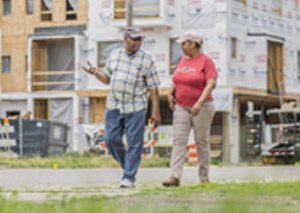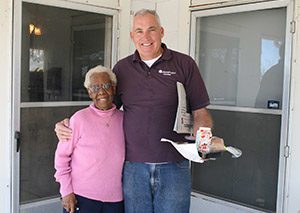By Michelle Betton, Writer
Across the country, unemployment numbers are down and the news talks of economic recovery and the booming stock market. Outside of that news, however, are many people who are still struggling to achieve equal opportunity and prosperity with the rest of the country.
Transformative investments are needed to get struggling Americans into the mainstream economy and working toward a brighter future.
This means access to health centers, charter schools, affordable housing, grocery stores that sell fresh and healthy food, transportation, and other infrastructure improvements. However, access to financing can be a major barrier to these projects getting off the ground.
Financial services, investment capital, and affordable credit from traditional financial institutions has historically been limited for those looking to serve low-income communities.
Community Development Financial Institutions (CDFIs) have played a major role in empowering communities to address the structural barriers that exclude them from shared prosperity.
What are CDFIs exactly? How do they work? Whom do they serve? Here is a breakdown…
Insight into CDFIs
CDFIs as we know them today began more than three decades ago as private financial institutions focused on increasing economic prosperity for low-income and underserved communities by providing affordable lending for community projects. Today, more than 1,000 CDFIs operate across the United States.
Over time, their work has evolved to address key issues of economic, social, racial, and political justice. These mission-driven institutions provide support in disinvested areas that traditional lending institutions deem too risky to finance; in fact, they are mandated to embrace risk in order to create social impact.
CDFIs fall into four sectors: community development banks, community development credit unions, community development loan funds, and community development venture capital funds. Each has a slightly different way of operating, but the end product is the same: communities of opportunity that break down barriers to success.
CDFIs work as market creators and market catalysts by supporting community businesses—including small and family businesses, micro-enterprises, cooperatives, non-profit social service organizations, mixed-use real estate, and affordable housing. CDFIs’ ability to foster catalytic change comes from loans and grants from government institutions like the CDFI Fund, loans and grants from large financial institutions, and program-related investments from major donors and foundations.
Financing from CDFIs targets specific populations – often low-income individuals in both urban and rural settings, and heavily concentrated with women and people of color. These high-impact interventions build community infrastructure and resilience.
CDFIs work for and with the communities they serve, developing strategic financing packages – ranging from pre-development to real estate acquisition, from construction to refinancing – for vital projects needed to help communities succeed. Generally smaller than mainstream financial lenders, CDFIs come in different sizes and provide loans ranging from $50,000 to $5 million. CDFIs have also jointly raised capital to deploy larger loans in the multi-millions.
In addition to core lending services, some CDFIs also provide capacity building, help build and scale social innovation programs and support policy advocacy as a means of further supporting local organizations. Combined with our lending services, these efforts promote increased job growth and retention, improving communities’ economic outlook and viability.
Importantly, CDFIs are not in business to maximize profits. Instead, CDFIs maximize support for community needs and empowerment.
CDFIs’ Immense Impact on Communities
The impact of CDFIs shows in their support and empowerment of underserved communities to address the barriers that hold them back from shared prosperity.
In 2016, CDFIs supported by the CDFI Fund financed nearly 12,000 businesses, created 37,600 jobs, and created 34,000 affordable housing units. Nearly 450,000 individuals received financial literacy capacity building through CDFIs. As part of the CDFI Fund’s Bond Guarantee Program, $119 million was spent on rental housing, $102 million on charter schools, $13.3 million for health care facilities, $2.7 million on daycare centers and $2.9 million on small businesses.
Capital Impact’s Role in the Space
Since 1982, Capital Impact has served often-neglected communities, starting with the cooperative model to foster economic development for low- and moderate-income areas.Our non-profit, mission-driven lending began in 1984 and progressively expanded to support communities nationwide, including establishing offices in Oakland, California and Detroit, Michigan. Capital Impact also grew to support access to quality health care, education, housing, healthy food, dignified aging and cooperative development.
Capital Impact works to improve the lives and futures of individuals and communities through four strategic pillars: addressing systematic poverty, building equitable communities, creating healthy communities, and ensuring inclusive growth.
 Since its inception, Capital Impact has deployed more than $3 billion for community development projects nationwide. In that time, our lending has created more than 36,500 units of affordable housing, helped more than 2 million patients receive quality health care, facilitated access to quality education for 240,000 students in 235 charter schools, financed 86 retailers to provide healthy food for 1 million people, helped 37,000 older adults age with dignity through 191 projects, and supported cooperative services for 870,000 customers. Our place-based strategy has also facilitated the revitalization of Detroit neighborhoods, creating mixed-use spaces and multi-family housing to help the city rebound.
In addition to our lending, we advance programs to create equity and opportunity. For example, our Equitable Development Initiative provides catalytic capital and training to minority real estate developers in Detroit so that they can participate in the city’s revitalization efforts. We are also investing nationally in efforts to scale worker-owned, home care cooperatives that are creating quality jobs for women aged 50 and older who care for our loved ones as they age.
Capacity building is another service we extend to organizations. A great example is the Answer Key, a step-by-step guide with practical tools designed to help charter school operators successfully navigate the often difficult process of building or expanding charter schools.
Like several other CDFIs, Capital Impact also embraced impact investing in 2017 by creating Capital Impact Investment Notes as a means to drive more capital from socially conscious investors – big and small – into the communities that need it most.
All that individuals and communities want is the opportunity to succeed. When traditional financial institutions refuse to invest in communities, CDFIs offer a chance of living a dream that so many Americans hold: providing their children with a quality education so that they can achieve greater gains. Receiving quality health care and healthy food access so that they can enjoy many years with family. Having affordable housing to call home.
In supporting communities to reach these goals, Capital Impact and other CDFIs help create equitable and inclusive spaces that lead to communities of opportunity for all.
###
About Capital Impact Partners: Through capital and commitment, Capital Impact Partners helps people build communities of opportunity that break barriers to success. We deliver strategic financing, incubate new social programs, and provide capacity-building to help ensure that low-to-moderate-income individuals have access to quality health care and education, healthy foods, affordable housing, and the ability to age with dignity. A nonprofit community development financial institution, Capital Impact Partners has disbursed more than $2 billion to revitalize communities over the past 30 years. Our leadership in delivering financial and social impact has resulted in Capital Impact earning a “AA” rating from S&P Global “AA” and being recognized by Aeris since 2005 for our performance. Headquartered in Arlington, VA, Capital Impact Partners operates nationally, with local offices in Detroit, MI, and Oakland, CA. Learn more at www.capitalimpact.org.
[dcwsb inline=”true”]
Since its inception, Capital Impact has deployed more than $3 billion for community development projects nationwide. In that time, our lending has created more than 36,500 units of affordable housing, helped more than 2 million patients receive quality health care, facilitated access to quality education for 240,000 students in 235 charter schools, financed 86 retailers to provide healthy food for 1 million people, helped 37,000 older adults age with dignity through 191 projects, and supported cooperative services for 870,000 customers. Our place-based strategy has also facilitated the revitalization of Detroit neighborhoods, creating mixed-use spaces and multi-family housing to help the city rebound.
In addition to our lending, we advance programs to create equity and opportunity. For example, our Equitable Development Initiative provides catalytic capital and training to minority real estate developers in Detroit so that they can participate in the city’s revitalization efforts. We are also investing nationally in efforts to scale worker-owned, home care cooperatives that are creating quality jobs for women aged 50 and older who care for our loved ones as they age.
Capacity building is another service we extend to organizations. A great example is the Answer Key, a step-by-step guide with practical tools designed to help charter school operators successfully navigate the often difficult process of building or expanding charter schools.
Like several other CDFIs, Capital Impact also embraced impact investing in 2017 by creating Capital Impact Investment Notes as a means to drive more capital from socially conscious investors – big and small – into the communities that need it most.
All that individuals and communities want is the opportunity to succeed. When traditional financial institutions refuse to invest in communities, CDFIs offer a chance of living a dream that so many Americans hold: providing their children with a quality education so that they can achieve greater gains. Receiving quality health care and healthy food access so that they can enjoy many years with family. Having affordable housing to call home.
In supporting communities to reach these goals, Capital Impact and other CDFIs help create equitable and inclusive spaces that lead to communities of opportunity for all.
###
About Capital Impact Partners: Through capital and commitment, Capital Impact Partners helps people build communities of opportunity that break barriers to success. We deliver strategic financing, incubate new social programs, and provide capacity-building to help ensure that low-to-moderate-income individuals have access to quality health care and education, healthy foods, affordable housing, and the ability to age with dignity. A nonprofit community development financial institution, Capital Impact Partners has disbursed more than $2 billion to revitalize communities over the past 30 years. Our leadership in delivering financial and social impact has resulted in Capital Impact earning a “AA” rating from S&P Global “AA” and being recognized by Aeris since 2005 for our performance. Headquartered in Arlington, VA, Capital Impact Partners operates nationally, with local offices in Detroit, MI, and Oakland, CA. Learn more at www.capitalimpact.org.
[dcwsb inline=”true”]

Through it’s place-based focus, Capital Impact has played an integral role in revitalization efforts in Detroit.












